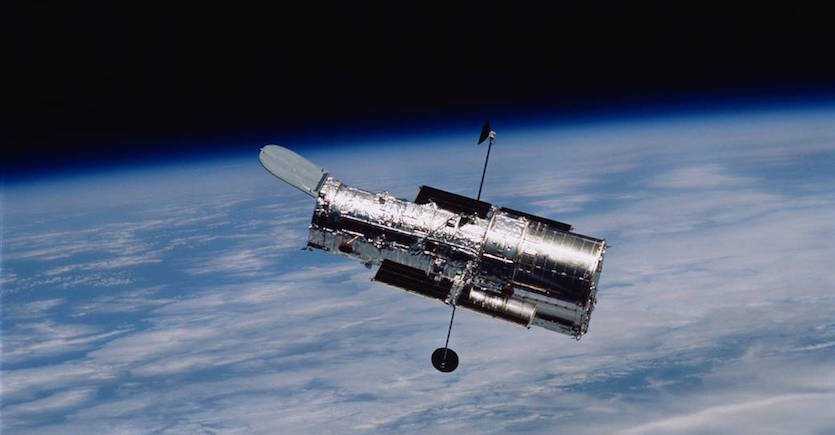
Melissa McGrath
Chief Scientist - NASA George C. Marshall Space Flight Center
Right smack in the middle of the country -- Grand Island, Neb.
I think it was probably watching the Perseid meteor shower when I was in high school. The Perseids are incredibly beautiful in the clear and dark skies of Nebraska. I also used to like to sleep outside on the diving board of our swimming pool because I loved to see the sky at night (no kidding). The only way you can sleep on a diving board is to lie flat on your back looking straight up at the sky.
I took an introductory astronomy class in college, followed by a one-month inter-term class in January 1974, which featured Carl Sagan. In addition to hearing him lecture, I read one of his books and had the opportunity to meet him in person. Carl Sagan inspired me to change my major that following semester from French to a double major in physics and astronomy. I followed the usual academic career by earning a Ph.D. from the University of Virginia and doing a post doctoral fellowship at Johns Hopkins University.
I then moved to a permanent job on the Space Telescope Science Institute science staff after my postdoc at Hopkins. The science operations for the Hubble Space Telescope are performed at STScI in Baltimore, which is on the Johns Hopkins University campus. After 13 years in that job, I moved to NASA Marshall Space Flight Center, where I have been for the last six years, except for one year at NASA Headquarters in 2005-2006.
My high school calculus teacher, Mr. Roger Harms -- my excellent training in calculus allowed me to become a successful scientist; Carl Sagan, who I admire immensely for his broad and deep intellect; Cecelia Payne-Gaposhkin, whose autobiography inspired my quest for respect and equality for women in science; Dr. Dorritt Hoffleit (at Yale University), who I worked for one summer on Nantucket; Dr. Margaret Kivelson (UCLA), who encouraged me when I was a very young scientist, providing me with sorely needed confidence to continue on as one of the few women in a male-dominated department.
Someone who constantly encourages, supports and articulates the value of science in a largely engineering agency. I provide high-level scientific leadership and strategic direction for the Marshall Space Flight Center. I also chair the American Astronomical Society's largest division: the Division for Planetary Sciences (1,500 members), and I am an associate scientific editor for The Astronomical Journal.
In 1975 I was one of only a handful of people in New England who witnessed the occultation of asteroid Eros by the star Kappa Geminorum. In order to see it we drove at break-neck speed south to intersect the ground track of the occultation -- because it changed at the last minute. We drove as far as we could before pulling off the interstate and onto a field, and it was a miracle that we got to see it happen. My results indicated that the asteroid had an elongated potato-like shape, which was controversial. (At the time people thought asteroids were all round.) This was proven to be correct later when the NEAR mission went to Eros.
The comet Shoemaker-Levy impacts with Jupiter were one of the highlights of my career. I led two of the six Hubble Space Telescope observing proposals. The team was fantastic, the anticipation was so exciting, and the results were truly astonishing and unbelievable. The press conferences, radio and TV appearances, and then a year of lecturing about the results all over the world were incredible. I still have a copy of the telegram we received, announcing that the ground-based infrared observers had seen bright fireballs. When we got this telegram we were nervous that Hubble might not see anything. When we saw the first Hubble pictures, it was just an unbelievable moment. (I bought the champagne that the team drank to celebrate, and I still have the bottle on my shelf among my "astronomical bottle" collection).
Other highlights of my career include my first Space Shuttle launch and the New Horizons launch in 2006. Presenting a colloquium at the Princeton Plasma Physics Lab and seeing my cross section paper on the desks of several of the scientists there was another high point in my career.
If you find something you love to do, it's not a job. You have to be willing to work very hard; that's more important than how smart you are, or where you went to school.
I think the quote that has always summed it up best for me is from Cecelia Payne-Gaposchkin's autobiography ("The Dyer's Hand"):
"Do not undertake a scientific career in quest of fame or money. There are easier and better ways to reach them. Undertake it only if nothing else will satisfy you; for nothing else is probably what you will receive. Your reward will be the widening of the horizon as you climb. And if you achieve that reward you will ask no other."
I enjoy reading, gardening, exercising (running, aerobics), travel, studying history, sewing, needlework and knitting. I am a sports fan: two of my favorite teams are the Red Sox and the NFL's New York Giants. I also like Nebraska football, SEC football, ACC basketball and professional tennis. I love to play cards, do Sudoku, and play Tetris, Solitaire, Word Twist and PathWords on the computer.
Do what you love, and love what you do. It takes hard work. Don't fool yourself into thinking that you can be really good at something without being willing to put in long hours to master it. Working hard and being dedicated has allowed me to succeed even though I am not brilliant.
Planetary science is a global profession.

